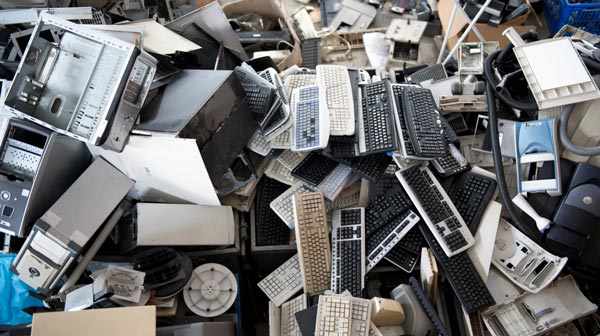Environmental Stewardship Made Easy: Choose R2 Certification Electronics Recycling
Wiki Article
Elevate Your E-Waste Monitoring With R2 Qualification: a Detailed Summary
One key technique to boost e-waste management methods is by acquiring R2 accreditation. By discovering the benefits and processes linked with R2 certification, a deeper understanding of exactly how it can revolutionize e-waste administration techniques arises, shedding light on a course towards sustainability and honest disposal methods.Relevance of E-Waste Administration

When e-waste is not handled appropriately, these hazardous substances can permeate into the environment, causing damage to wild animals and potentially getting in the food chain, posturing risks to human wellness. Additionally, the incorrect disposal of e-waste adds to contamination and greenhouse gas exhausts, intensifying environment modification and environmental deterioration.

Advantages of R2 Qualification

To start with, R2 certification boosts reliability by showcasing a company's dedication to sustainable techniques. It guarantees consumers, companions, and stakeholders that the company abides by stringent requirements for e-waste monitoring - r2 certification. This trustworthiness can cause increased depend on and boosted relationships with clients that focus on environmental obligation
Second of all, R2 certification assists minimize risks connected with incorrect e-waste disposal. By adhering to the strict guidelines set forth by the qualification, companies can minimize the probability of information breaches, ecological contamination, and lawful effects. This proactive method safeguards the business's track record and lessens possible liabilities.
Lastly, R2 certification demonstrates a commitment to ecological stewardship - r2 certification. By responsibly handling digital waste through accredited processes, organizations add to the conservation of resources, reduction of contamination, and promotion of a circular economic situation. This commitment not only benefits the setting yet likewise lines up with progressing consumer expectations for lasting organization techniques
R2 Qualification Refine Introduction
Having actually established the advantages of R2 accreditation in promoting integrity, risk mitigation, and ecological stewardship, it is important to now lay out the thorough procedure included in obtaining this certification. The R2 qualification procedure starts with a complete evaluation of the organization's functional policies and procedures to make certain conformity with the R2 imp source requirement. This preliminary assessment is critical in recognizing any type of gaps that require to be dealt with before continuing even more.Once the company's techniques line up with the R2 conventional demands, an independent third-party auditor conducts an on-site audit to examine the implementation and efficiency of these techniques. This audit consists of an extensive evaluation of documentation, meetings with team, and physical assessments of centers to confirm compliance.
Adhering to a successful audit, the company gets a qualification decision based upon the auditor's findings. If approved, the company is approved R2 certification, demonstrating its dedication to responsible e-waste monitoring. It is essential to keep in mind that maintaining R2 accreditation requires continuous conformity with the standard's demands and routine audits to guarantee ongoing adherence to ideal practices in e-waste recycling and disposal.
Secret Criteria for R2 Conformity
A vital facet of achieving R2 compliance is making sure that all digital waste (e-waste) processing facilities satisfy rigorous ecological and safety requirements. To abide with R2 requirements, organizations need to abide by key criteria that focus on accountable e-waste useful site management methods. These read more standards consist of implementing a documented environmental, health and wellness, and security monitoring system, making certain the secure handling of data-containing gadgets, and performing comprehensive downstream due diligence to track the final destination of e-waste materials.Furthermore, R2 compliance necessitates the proper testing, repair, and recycling of digital tools to prolong its useful life and minimize environmental influence. Facilities looking for R2 qualification have to additionally prioritize employee health and wellness by giving essential training, individual safety devices, and a safe working atmosphere. Furthermore, preserving comprehensive records of e-waste handling tasks and consistently undertaking audits by recognized accrediting bodies are important elements of demonstrating ongoing conformity with R2 requirements.
Effects of Sustainable E-Waste Practices
The execution of lasting e-waste practices based on R2 conformity not just makes certain environmental and safety criteria are satisfied but additionally dramatically affects the overall lifecycle of digital products. By sticking to R2 requirements, digital waste monitoring processes come to be a lot more efficient, lowering the environmental impact of electronic products. Sustainable e-waste methods help with the correct disposal of digital elements, ensuring that hazardous products are taken care of properly and do not finish up polluting the setting.Furthermore, lasting e-waste techniques can add to work production in the recycling and refurbishment sectors, promoting financial development while advertising ecological responsibility. Overall, the adoption of sustainable e-waste practices under R2 certification serves as an essential step towards accomplishing a more ecologically sustainable electronics industry.
Conclusion
Finally, implementing proper e-waste management practices is essential for environmental sustainability and resource conservation. R2 qualification plays a vital duty in making sure accountable handling and disposal of digital waste. By sticking to the rigid requirements set forth by R2 standards, organizations can not just lessen their environmental impact yet additionally add to a much more sustainable future for generations to find.One key technique to elevate e-waste monitoring techniques is by obtaining R2 accreditation. By exploring the processes and advantages connected with R2 accreditation, a much deeper understanding of exactly how it can transform e-waste management strategies arises, dropping light on a path in the direction of sustainability and honest disposal practices.
The R2 qualification process starts with a complete evaluation of the company's operational policies and procedures to make sure compliance with the R2 criterion. If approved, the company is given R2 qualification, demonstrating its dedication to responsible e-waste management. Overall, the adoption of lasting e-waste practices under R2 qualification serves as a critical step in the direction of achieving a much more environmentally lasting electronics sector.
Report this wiki page